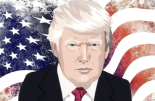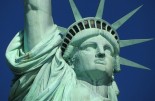Han Dieperink: Ten factors that influence the dollar

This column was originally written in Dutch. This is an English translation.
By Han Dieperink, written in a personal capacity
Asking the question 'What do you think of the dollar?' is relatively easy. However, answering that question isn't. One answer that always rings true to this question is that the dollar will likely remain the U.S. currency for years to come. Yet that is not what the questioner wants to know.
Predicting the dollar is not easy. There are (at least) ten factors that influence this currency. Those factors can still be identified, but the problem lies in the weight to be given to those factors. Currency markets are quite monogamous. Usually there is a strong emphasis on one specific factor and the other factors do not seem to play a role until they do.
Below is an overview of the ten factors that influence the dollar:
1) A strong economy also requires a strong currency. In that respect, it is explicable that the dollar, for example, is stronger than the euro. Especially now that the euro has slid towards a stagflation scenario in recent months while the American economy appears to be making a perfect landing, this helps the dollar. In the long term, economic growth is rather an argument why the dollar will ultimately lose out compared to, for example, the renminbi.
2) The dollar is a special currency. It is still the world's reserve currency, which essentially makes the United States the banker for the rest of the world. This makes it possible and even desirable to continually run a current account deficit. This shortage makes the reserve currency look fundamentally weak, but is actually relatively strong.
A well-known example in this context is the graph of the dollar smile, a graph where the dollar is strong when there is a crisis (everyone flees to the dollar) or at the other extreme when the American economy is doing very well. In both cases the dollar rises. Only in between, the dollar tends to fall, because that's when the fundamentals come to the surface.
3) Interest rate differences can have a major impact. If you want to arbitrage currencies, you will of course receive the interest in the currency you are long and pay the interest in the currency you are short. For example, the proverbial Mrs. Watanabe borrowed for years in yen, which she exchanged for dollars, among other things. However, this option no longer applies due to recent developments in Japan (inflation).
4) Monetary policy. At a time when the Fed is slamming on the brakes and other central banks are still easing quantitatively, this is good for the dollar. Not only the interest rate differences play a role here, but especially how future monetary policy will differ from the policy that the market is currently calculating.
5) Geopolitical relations. The United States has used the dollar as a weapon against the Russians. The Russians have no use for dollars because they can no longer pay with them via the financial system (Swift). After all, their accounts are blocked.
Other countries that sometimes also have a difficult relationship (or may have one in the future) take this into account. Rich Arabs and Chinese billionaires are therefore better off not holding dollars. Before you know it, they are in the same boat as the Russian oligarchs. Furthermore, in this context the negative effect of polarization within American politics should not be underestimated. That doesn't help the dollar.
6) Dedollarization. Since the Great Financial Crisis, the Chinese have wanted to get rid of their dependence on the dollar. This was not so much because of a deteriorating relationship with the US, but mainly because the Chinese economy was too dependent on the dollar and therefore on American banks. In fact, Asian countries have been working to reduce their dependence on the dollar since the 1997 Asian crisis.
By the way, it is not that easy to say goodbye to the reserve currency. It's just like Microsoft's operating system. It's not the best operating system, but because everyone uses it, it's hard to ignore. In recent times, you have seen a de-Euroisation, which is of course also related to European sanctions against the Russians. This has reduced the attractiveness of the euro for wealthy people outside the eurozone. The share of the euro in world trade is gradually decreasing and the share of the renminbi is increasing. However, the dollar remains by far the most important currency.
7) Twin deficits. Countries with persistent budget and current account deficits have weak currencies, but this apparently does not apply to the dollar. The risk, however, is that if the dollar loses its reserve status, the dollar could also quickly go in the other direction.
Because of the deficits, the rest of the world is essentially financing the US deficits and the US economy. This is the privilege of the residual coin. The United States is home to 5% of the world's population, but the share of current account deficits is 60%. Furthermore, 40% of the US budget deficit is structurally financed by foreign countries.
8) Debts. Countries with high debts (to foreign countries) can always repay their debts, provided they have their own currency. The big question is what the value of the coin is. The mechanism of financial repression and reflation causes the nominal economy to grow faster than nominal debt, often through higher inflation.
The US national debt recently exceeded $33 trillion. Furthermore, credit rating agencies S&P and Fitch have downgraded the United States from AAA to AA, but in a world where there is a dire shortage of risk-free paper, American Treasuries will continue to fulfill this role for the time being.
9) Cash flows. Many factors are more fundamental in nature, but ultimately money flows determine the strength of the currency. A good example is the year 2001. At that time, almost all of the above factors would argue for a weak dollar, but because the renminbi was then pegged to the dollar, a lot of money flowed into the dollar (thanks to China's entry into the WTO). dollar-renminbi block.
This is also possible, for example, when oil prices are high (oil is still largely traded in dollars). As for the high oil price, Europe now has to purchase energy in dollars (until recently this was mainly in euros) and Europe must of course first earn those dollars.
10) Positioning. In addition to money flows and fundamental factors, everything can be changed if there is extreme positioning. If the market is fully committed to a weakening of the dollar, you are more likely to see a stronger dollar in the shorter term. This is because in principle all other factors have already been factored into the price of the dollar. And if everyone is negative, stock market sentiment can only become more positive, causing the dollar to rise again.
To estimate the development of the dollar, it is important to know how the market views these ten factors and to estimate how your own scenario deviates from the market scenario.
Europeans tend to underestimate the strength of the dollar, but in the longer term a weaker dollar seems a justified prediction, especially against Asian currencies. The trigger for this in the short term could be a mild recession in the US next year, although, for example, the shutdown of the US government due to the credit ceiling and the US presidential elections next year could also be a reason for a weaker dollar.









